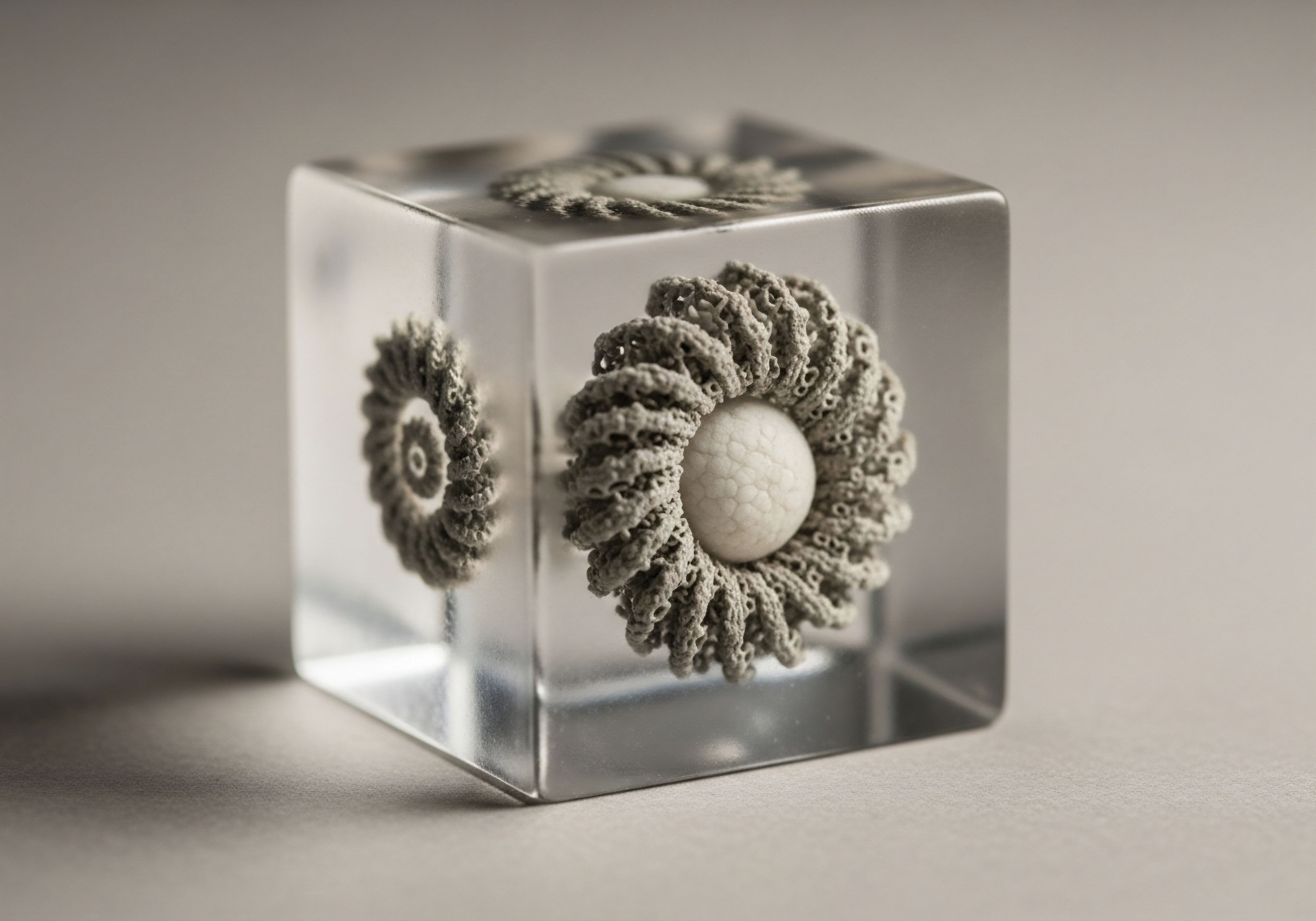

Fundamentals
The experience of a decline in sexual vitality is often felt as a profound disconnect, a conversation between mind and body where the signals have become crossed or muted. You may feel the cognitive flicker of desire, yet the physical response remains absent.
Or perhaps the body is willing, but the essential, initiating spark of arousal in the mind fails to ignite. This is a deeply human and often disquieting experience, one that speaks to a disruption within the intricate communication network that governs our most personal functions.
Understanding this network is the first step toward recalibrating it. The journey into restoring this vital aspect of well-being begins with recognizing that sexual response is a complex physiological event, orchestrated by a precise interplay of hormones, neurotransmitters, and vascular function. It is a symphony, and when one section is out of tune, the entire composition is affected.
At the heart of this internal orchestra are specific biological messengers and pathways. We can begin to understand the available therapeutic options by mapping them to the part of the system they are designed to support. PT-141, a peptide known clinically as bremelanotide, functions as a direct communication to the brain’s primary control center for sexual desire.
It is a synthetic analog of a naturally occurring hormone, alpha-melanocyte-stimulating hormone (α-MSH), which plays a significant role in regulating sexual behavior. Its mechanism is targeted and specific, initiating the cascade of neurological events that we perceive as arousal and desire. It effectively sends a clear, unambiguous signal to the part of the brain responsible for wanting, prompting the rest of the system to come online.
Contrast this with a different class of interventions, the phosphodiesterase type 5 (PDE5) inhibitors, which include well-known medications like sildenafil (Viagra) and tadalafil (Cialis). These compounds work on a separate, downstream part of the physiological process. They target the vascular machinery itself, the network of blood vessels responsible for the physical manifestations of arousal.
PDE5 inhibitors act by enhancing the effects of nitric oxide, a chemical released during sexual stimulation that relaxes smooth muscles and allows for increased blood flow. Their function is to ensure that when the brain sends the signal for arousal, the body’s physical infrastructure can respond efficiently. They amplify an existing signal; they do not create the signal itself. This distinction is fundamental. One addresses the initiation of desire, while the other facilitates the physical execution of that desire.
A third layer of intervention involves hormonal optimization, particularly the role of testosterone. Testosterone functions as the foundational operating system for the entire sexual response cycle in both men and women. It sets the baseline level of receptivity in both the brain’s desire centers and the body’s vascular tissues.
Adequate testosterone levels ensure that the androgen receptors in the hypothalamus are sensitive to arousal triggers and that the enzymes responsible for producing nitric oxide in blood vessels are functioning optimally. When testosterone is deficient, the entire system is handicapped.
The command center may be less inclined to send signals, and the physical machinery may be less capable of responding to them. Therefore, testosterone replacement therapy (TRT) is a systemic approach, aimed at restoring the body’s core biochemical environment to one that is permissive and supportive of healthy sexual function.


Intermediate
To make an informed decision about a personalized wellness protocol, one must appreciate the precise biological mechanisms that differentiate these therapeutic pathways. Each intervention targets a distinct stage in the complex cascade of sexual response, from the cerebral origins of desire to the physiological culmination of arousal. Understanding this specificity allows for a more targeted and effective application, tailored to the individual’s unique physiological landscape.
The choice of intervention is determined by identifying the specific point of failure in the neuro-hormonal-vascular cascade of sexual response.

PT-141 a Central Nervous System Agonist
PT-141, or bremelanotide, operates within the central nervous system, a domain distinct from the vascular system targeted by PDE5 inhibitors. Its primary action is as an agonist at melanocortin receptors, particularly the MC4R and to a lesser extent, the MC3R, which are densely expressed in the hypothalamus.
The hypothalamus is a primitive, powerful region of the brain that governs fundamental drives, including appetite, thirst, and sexual behavior. When PT-141 binds to these receptors, it initiates a series of downstream neurochemical events. The most significant of these is the modulation of dopamine release in key neural circuits, such as the medial preoptic area (mPOA) of the hypothalamus.
Dopamine is a primary neurotransmitter associated with motivation, reward, and desire. By increasing dopaminergic activity in these specific pathways, PT-141 directly enhances the cognitive experience of sexual desire.
This central mechanism explains its approval for Hypoactive Sexual Desire Disorder (HSDD) in premenopausal women, a condition characterized by a distressing lack of sexual thoughts, fantasies, and desire for activity. Its utility extends, through off-label application, to men experiencing low libido or erectile dysfunction with a psychological or neurological component. The administration protocol, typically a subcutaneous injection administered about 45 minutes before anticipated sexual activity, reflects its role as an on-demand initiator of the brain’s arousal circuits.

PDE5 Inhibitors Vascular System Facilitators
The mechanism of PDE5 inhibitors is entirely peripheral, focused on the smooth muscle tissue of the vascular system. Sexual stimulation triggers the release of nitric oxide (NO) from nerve endings and endothelial cells in the penile corpus cavernosum or clitoral tissues. Nitric oxide, in turn, stimulates an enzyme called guanylate cyclase, which produces cyclic guanosine monophosphate (cGMP).
It is cGMP that acts as the critical intracellular messenger, causing the relaxation of smooth muscle tissue. This relaxation allows arterial blood to flow into the erectile tissues, leading to engorgement and erection in men, and clitoral and labial engorgement in women.
The process is naturally regulated by the enzyme phosphodiesterase type 5 (PDE5), which breaks down cGMP, causing the response to subside. PDE5 inhibitors work by blocking this enzyme. By preventing the degradation of cGMP, they allow it to accumulate, thus prolonging and strengthening the smooth muscle relaxation and blood flow.
This mechanism is wholly dependent on an initial, arousal-driven release of nitric oxide. Without that initial spark from the nervous system, PDE5 inhibitors have no effect. They are amplifiers of a response, not creators of one.

How Does the Body’s Signaling Cascade Determine Treatment Choice?
The decision between these interventions hinges on a careful diagnosis of where the signaling cascade is faltering. Is the issue a failure to launch the initial desire signal from the brain? Or is the signal being sent, but the physical apparatus is failing to respond?
A person who feels desire but experiences performance issues may be an ideal candidate for a PDE5 inhibitor. Conversely, an individual who feels a complete absence of libido, for whom the initial spark is the primary problem, may find greater benefit from a centrally acting agent like PT-141.
For many, the issue is multifactorial, where low systemic testosterone contributes to both diminished central desire and reduced peripheral vascular responsiveness, necessitating a foundational approach with hormonal optimization before or alongside other therapies.
The following table provides a comparative overview of these distinct interventions.
| Feature | PT-141 (Bremelanotide) | PDE5 Inhibitors (e.g. Sildenafil) | Testosterone Replacement Therapy (TRT) |
|---|---|---|---|
| Primary Target System | Central Nervous System (Hypothalamus) | Peripheral Vascular System (Erectile Tissues) | Systemic Endocrine Environment |
| Core Mechanism | Melanocortin Receptor Agonist (MC4R, MC3R) | Inhibition of PDE5 Enzyme | Androgen Receptor Agonist |
| Key Biological Effect | Increases Dopamine; Initiates Sexual Desire | Increases cGMP; Facilitates Blood Flow | Primes Neural and Vascular Tissues; Supports Libido and NO Production |
| Primary Clinical Use | Hypoactive Sexual Desire Disorder (HSDD) | Erectile Dysfunction (ED) | Hypogonadism; Low Libido |
| Stimulus Dependency | Generates central desire independent of external stimuli | Requires external sexual stimulation to trigger NO release | Creates a permissive state; does not directly cause arousal |
| Onset of Action | ~45 minutes post-injection | 30-60 minutes post-ingestion | Weeks to months for full systemic effect |

Other Targeted Interventions
Beyond these primary categories, other specialized treatments exist. Prostaglandin-based therapies like Alprostadil, for instance, can be administered as an injection or intraurethral suppository. Alprostadil works directly on tissues to increase cyclic AMP (cAMP), another messenger that promotes smooth muscle relaxation and vasodilation, independent of the nitric oxide pathway.
This makes it an option for men who do not respond to PDE5 inhibitors. However, its application is localized and invasive, and it does not address the central components of desire. Each of these tools has a specific purpose, and understanding their distinct mechanisms is paramount to constructing a logical, effective, and truly personalized protocol for restoring sexual health.
- PT-141 directly initiates the desire signal in the brain’s hypothalamus.
- PDE5 Inhibitors amplify the physical response to an existing desire signal in the vascular tissue.
- Testosterone Therapy restores the foundational hormonal environment required for both brain and body to function optimally.
- Alprostadil provides a direct, localized vascular effect, bypassing the typical nitric oxide pathway.


Academic
A sophisticated understanding of sexual health interventions requires moving beyond a simple list of medications and their targets. It necessitates a deep appreciation for the neuroendocrinology of sexual function, viewing it as a vertically integrated system where systemic hormones, central neurotransmitters, and peripheral vascular responses are in constant, dynamic communication.
The central governor of this entire process, integrating hormonal readiness with environmental cues to produce the final output of desire and arousal, is the melanocortin system. PT-141’s uniqueness comes from its ability to directly engage this master regulatory system.
The melanocortin system functions as a critical integration point, translating the body’s systemic hormonal state into the specific neural activity of desire.

The Melanocortin System a Master Regulator
The melanocortin system is an ancient and highly conserved signaling pathway in the central nervous system. It consists of peptides derived from a precursor molecule called pro-opiomelanocortin (POMC), and a family of five G-protein coupled receptors (MC1R through MC5R).
While best known for its role in skin pigmentation (MC1R) and adrenal function (MC2R), its function in the brain via the MC3R and MC4R subtypes is profoundly important for regulating energy homeostasis, appetite, and sexual behavior. These receptors are densely concentrated in key hypothalamic nuclei, including the paraventricular nucleus (PVN), the ventromedial nucleus (VMN), and the medial preoptic area (mPOA), all of which are critical nodes in the neural circuitry of sexual function.
Research demonstrates that endogenous melanocortin peptides, like α-MSH, are potent facilitators of sexual response. When these peptides bind to MC4R in the PVN, they trigger a cascade that results in the activation of oxytocinergic and dopaminergic neurons that project to other brain regions and the spinal cord.
This provides a direct, mechanistic link between melanocortin signaling and the pro-erectile and pro-arousal pathways. Bremelanotide (PT-141) acts as a synthetic mimic of this endogenous process, reliably activating this central command pathway on demand.

What Is the Role of the Melanocortin System in Integrating Hormonal and Neural Signals for Sexual Function?
The true elegance of this system lies in its role as an integrator. The expression and sensitivity of melanocortin receptors are themselves modulated by the background hormonal milieu, particularly by sex steroids like testosterone. Testosterone, acting through its conversion to estradiol in the brain, appears to enhance the responsiveness of these hypothalamic circuits.
This creates a synergistic relationship ∞ adequate testosterone levels prime the system, making the melanocortin pathways more sensitive to pro-sexual stimuli. This explains why an individual with severe hypogonadism may experience a blunted response to PT-141; the foundational “volume” of the system, controlled by testosterone, is turned down too low for the specific “play” signal of the melanocortin agonist to be fully effective.
This integrated view allows us to construct a more complete hierarchy of intervention. The foundational layer is ensuring endocrine sufficiency through hormonal optimization. The second layer is addressing the central initiation of desire, the primary domain of PT-141. The third layer is ensuring the integrity of the peripheral vascular response, the domain of PDE5 inhibitors.

A Comparative Analysis of Neurotransmitter Effects
The ultimate output of these interventions can be understood by examining their effects on key neurotransmitter systems. Sexual desire is largely driven by the mesolimbic dopamine pathway, often called the “reward pathway.” Arousal and performance involve a complex interplay between dopamine (pro-sexual), norepinephrine (pro-arousal), and serotonin (often inhibitory, especially regarding ejaculation).
| Intervention | Primary Neurotransmitter Effect | Secondary Effects | Resulting Subjective Experience |
|---|---|---|---|
| PT-141 (Bremelanotide) | Increases dopamine release in the mPOA and nucleus accumbens via MC4R activation. | Modulates oxytocin and norepinephrine pathways. | Increased motivation, desire, and thoughts about sex. Heightened arousal. |
| Testosterone | Increases dopamine synthesis and receptor density in key brain regions over time. Increases nitric oxide synthase. | Modulates serotonin and GABA systems, promoting a general sense of well-being. | Global increase in libido, energy, and mood. Enhanced systemic readiness for arousal. |
| PDE5 Inhibitors | No direct central neurotransmitter effect. The primary action is peripheral. | Psychological confidence from reliable physical function may indirectly influence central pathways. | Improved physical response to arousal; does not directly generate desire. |
| Apomorphine (Dopamine Agonist) | Directly stimulates D1/D2 dopamine receptors in the hypothalamus and other brain regions. | Can cause significant side effects like nausea due to less targeted action. | Rapid onset of arousal and erection; historically used but largely replaced. |
Effective treatment requires a systems-based approach that acknowledges the distinct yet interconnected roles of hormones, central neurotransmitters, and peripheral vascular function.
This academic perspective reveals that PT-141 is a highly sophisticated tool. Its value lies in its specificity, targeting the precise neurological event that represents the genesis of sexual desire. It is a molecule that speaks the brain’s own language of arousal. When compared to other interventions, it occupies a unique and critical niche.
PDE5 inhibitors ensure the engine can run, and testosterone ensures there is fuel in the tank, but PT-141 is akin to turning the key in the ignition. For the growing number of individuals whose primary challenge lies in that initial, central spark, it represents a targeted and mechanistically elegant solution.
- System Integration The melanocortin system acts as a bridge between the body’s hormonal state and the brain’s neural circuits for desire.
- Neurotransmitter Cascade PT-141’s primary effect is the targeted release of dopamine, the key neurotransmitter for motivation and reward, in sexually relevant brain regions.
- Therapeutic Hierarchy A comprehensive approach first ensures hormonal balance (Testosterone), then addresses central desire (PT-141), and finally supports peripheral function (PDE5 inhibitors).

References
- Clayton, Anita H. et al. “Bremelanotide for female sexual dysfunctions ∞ good for the CURE?” Expert Opinion on Pharmacotherapy, vol. 7, no. 17, 2006, pp. 2389-2398.
- Pfaus, James G. et al. “The neurobiology of bremelanotide for the treatment of hypoactive sexual desire disorder in premenopausal women.” CNS Spectrums, vol. 26, no. 5, 2021, pp. 498-508.
- Simon, James A. et al. “Long-Term Safety and Efficacy of Bremelanotide for Hypoactive Sexual Desire Disorder.” The Journal of Sexual Medicine, vol. 16, no. 11, 2019, pp. 1826-1836.
- Rosen, Raymond C. and Jennifer A. Avina. “Melanocortins in the treatment of male and female sexual dysfunction.” Current Sexual Health Reports, vol. 2, no. 4, 2005, pp. 145-151.
- Molinoff, Perry B. et al. “Bremelanotide ∞ a novel melanocortin agonist for the treatment of female sexual dysfunction.” Annals of the New York Academy of Sciences, vol. 994, no. 1, 2003, pp. 96-102.
- Shadiack, Annette M. et al. “Melanocortin receptor agonists for the treatment of sexual dysfunction.” Current Topics in Medicinal Chemistry, vol. 7, no. 11, 2007, pp. 1137-1144.
- Hadley, Mac E. and Robert T. Dorr. “Melanocortin-based therapeutics ∞ a new class of drugs for treating sexual dysfunction.” Current Opinion in Investigational Drugs, vol. 4, no. 4, 2003, pp. 406-412.
- King, Stephen H. et al. “Melanocortin receptors, melanotropic peptides and penile erection.” Current Topics in Medicinal Chemistry, vol. 7, no. 11, 2007, pp. 1098-1106.

Reflection

Charting Your Own Biological Map
The information presented here offers a map of the intricate biological territory governing sexual health. It details the pathways, the messengers, and the various points of intervention. This knowledge is a powerful tool, shifting the perspective from one of passive suffering to one of active, informed inquiry.
The purpose of this detailed exploration is to equip you with a new language to understand your own body’s signals. It allows you to move beyond a vague sense of “low libido” or “performance issues” and begin to ask more precise questions.
Consider your own experience through this systemic lens. Where does the conversation between your mind and body seem to break down? Is the initial impulse, the very thought of desire, the missing element? Does the desire feel present, yet the physical response feels distant or unreliable?
Or is there a more pervasive feeling of low energy and vitality that affects all aspects of your life, including this one? Your lived experience contains the data. The biological mechanisms described here provide the framework for interpreting that data. This process of self-knowledge is the essential first step.
A therapeutic journey is most effective when it is a collaboration, a partnership between your personal expertise on your own body and a clinician’s expertise on the systems that govern it. The path forward begins with this synthesis of knowledge and experience, empowering you to seek a solution that is not just a generic treatment, but a personalized recalibration of your unique system.

Glossary

vascular function

sexual desire

pde5 inhibitors

nitric oxide

sexual response cycle

sexual function

central nervous system

hypoactive sexual desire disorder

nervous system

melanocortin system




